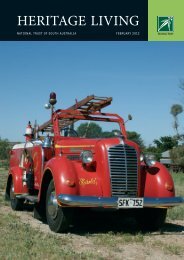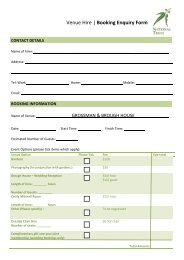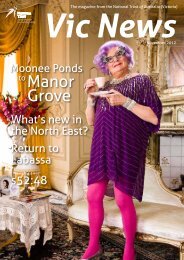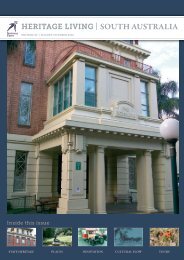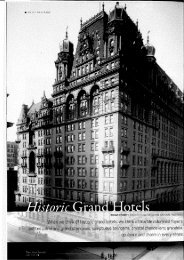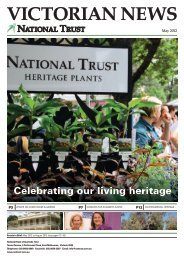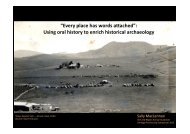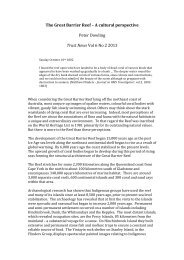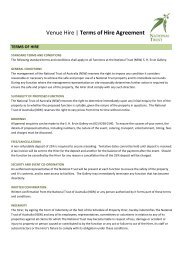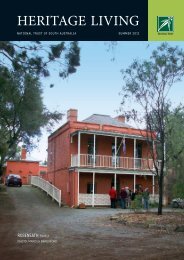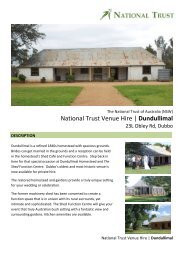Heritage Living Winter 2011 - National Trust of Australia
Heritage Living Winter 2011 - National Trust of Australia
Heritage Living Winter 2011 - National Trust of Australia
Create successful ePaper yourself
Turn your PDF publications into a flip-book with our unique Google optimized e-Paper software.
<strong>Heritage</strong> <strong>Living</strong>national TRust <strong>of</strong> South <strong>Australia</strong>trust news<strong>Australia</strong>n author Nancy Cato starts her historicalnovel The Lady Lost in Time (about actual 17 thcentury British portrait painter MaryBeale) with her discovery in 1960 <strong>of</strong> aforgotten, damaged portrait attributedto Beale in a decaying old 2 storeywarehouse and dwelling at Milang oncebelonging to a Murray Darling Riversmerchant. Was this AH Landseer’s, orwas it simply some fictional device? ANTSA classified Milang Wool Shed datedc1860 was demolished in 1975.Such musings remind <strong>of</strong> the onceso culturally and economicallyimportant river trade, which the NTSA hopes willbe recognised through its <strong>2011</strong> nomination <strong>of</strong> theMurray Bridge Historic Transport Hub, a key node inthe river, rail and road transport networks focussedaround the River Murray and Lower Lakes.References:Nancy Cato The Lady Lost in Time (Collins Sydney 1986)<strong>Heritage</strong> <strong>of</strong> <strong>Australia</strong> (Macmillan South Melbourne 1981) p2/281<strong>National</strong> <strong>Trust</strong> <strong>of</strong> SA Register <strong>of</strong> Historic Buildings 4 th edn 1980Thorne & Collocott (eds) Chambers Biographical Dictionary(Edinburgh 1990)Websites: www.murrayriver.com.au/paddleboats/river-boattrading-milang/;morgan.org.au/html/museum.html; gabr.net.au/archives/ABEO562a.html; flotilla-australia.com/saother.html#;rivermurrayshop.com.au/Paddlesteamers.html; visitoutbacknsw.com/Wilcannia-nsw.html; smh.com.au/travel; postcards-sa.com; WikipediaEvocative Victor Harbor MuseumMarcus BeresfordThe <strong>National</strong> <strong>Trust</strong> operated Encounter CoastDiscovery Centre, on Flinders Parade VictorHarbor, <strong>of</strong>fers many interesting insights into thehistory <strong>of</strong> the area. It is housed in the originalCustoms House, built in 1866 (using stoneballast from sailing ships). This later became theharbour-master’s and railway station-master’sresidence.A pr<strong>of</strong>essionally constructed display focuses onthe post-European settlement period, althoughthere is a section on the Ngarrindjeri Aborigines.Whaling occurred for a long period beforeformal colonisation and <strong>of</strong> particular interestis the display <strong>of</strong> a twisted and coiled harpoon,illustrating one valiant, painful struggle.As an aside, historian JS Cumpston remindswhat a massive industry whaling once was inthe region, in his book Kangaroo Island 1800-36(Roebuck Books Canberra 1986 pp155-74). Inone season, for example, the South <strong>Australia</strong>nCompany reported an output <strong>of</strong> 200 tons <strong>of</strong> oiland 10 tons <strong>of</strong> bone from its “Black” (SouthernRight) whale fishery at Encounter Bay. This wasvalued at $13,200. The following year (1838) some160 tons <strong>of</strong> oil was shipped to London, in 1839 itwas 176 tons and in 1840 some 237 tons. By 1841the company’s single whaling party at EncounterBay procured only 134 tons <strong>of</strong> oil and 6 tons <strong>of</strong>bone. The decline in output and pr<strong>of</strong>itability wasattributed to “foreign” ships being allowed towhale in the region - it was reported that in 1841there were over 30 such vessels operating in theregion. It is interesting to speculate that if thesingle Encounter Bay operation procured 134tons <strong>of</strong> oil, presumably 30 ships would have beenprocuring upwards <strong>of</strong> 4000 tons <strong>of</strong> oil in that year.As to the numbers <strong>of</strong> whales involved, one reportin the South <strong>Australia</strong>n Register <strong>of</strong> 18 June 1836talks <strong>of</strong> two ships obtaining 400 tons <strong>of</strong> oil (and170 whales) in one season.The museum display looks at other intriguingmaritime history, and early settlers <strong>of</strong> the region(including the Newland family whose memberSimpson went on the write the excellent historicalnovel about the whaling era, Paving the Way in1893).The main Customs House includes an interestingdisplay on guest houses <strong>of</strong> Victor Harbor,underlining the importance <strong>of</strong> the town as aresort since early days. The phenomenon <strong>of</strong> guesthouses probably belongs to a past era despitetheir immortalisation in the TV comedy “FawltyTowers”, and the two room display stronglyevokes the atmosphere <strong>of</strong> a guest house or early20 th century provincial hotel. Elsewhere, superbcradle-backed wooden chairs evoke the building’stime as a railway building, while other roomsallude to its use as a domestic dwelling.In short, the museum captures the essence <strong>of</strong>important phases in the history <strong>of</strong> Victor Harbor.Visitors can also pick up excellent Old Port Victorand Victor Harbor Historic Markers Discovery Trailleaflets at the museum and wander around thecentral section <strong>of</strong> the town and read about otherlocal heritage sights.page 15



